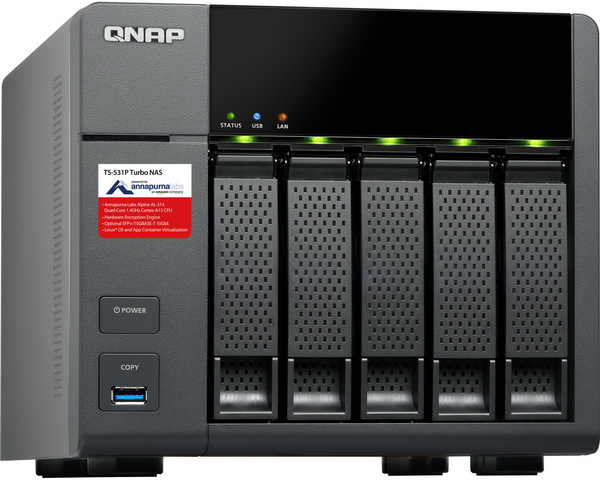INTRODUCTION
Sharing data on a local network, uploading/downloading files to/from the internet via FTP/Torrent and recording feed from IP security cameras are the three main uses people tell me they have when they approach me asking for the ideal network attached storage server to cover their needs. It goes without saying that NAS servers can be used for a very long list of things (including local/cloud backups, media streaming/playback, email filtering, web hosting, VoIP communications, virtualization and much more) but it always comes down to what you want one for so at the end of the day why pay for features you don't want if you can skip them? The brand new 5-bay TurboNAS TS-531P by QNAP offers everything most professionals (and of course home users) would ever want from a NAS server minus the HDMI output and today it's up to us to see exactly what you can expect from it both in terms of features and performance.
QNAP Systems, Inc., as its brand promise "Quality Network Appliance Provider", aims to deliver comprehensive offerings of cutting edge network attached storage (NAS) and network video recorder (NVR) solutions featured with ease-of-use, robust operation, large storage capacity, and trustworthy reliability. QNAP integrates technologies and designs to bring forth quality products that effectively improve business efficiency on file sharing, virtualization applications, storage management and surveillance in the business environments, as well as enrich entertainment life for home users with the offering of a fun multimedia center experience. Headquartered in Taipei, QNAP delivers its solutions to the global market with nonstop innovation and passion.
In all the years I’ve been using and testing NAS servers I’ve seen numerous models running on Marvell, AMD and Intel CPUs but the TS-531P is actually the very first one using the Alpine AL-314 quad-core 1.4GHz cortex A15 processor by Annapurna Labs (Synology also has a model with this CPU in the market. Unfortunately not much is known about this CPU (aside the fact that it offers AES 256-bit hardware encryption) since Annapurna Labs was basically an unknown company until they were bought by Amazon a while back. The TS-531P also features 5 SATA III bays (can be configured in RAID0/1/5/6/10 + hot spare), 512MB of flash memory, 2/8GB of DDR3-1600 RAM (expandable to 16GB), 4 RJ45 Gigabit Ethernet ports, 3 USB 3.0 ports and a PCIe Gen2x4 slot which can be used with an optional single-port 10GbE SFP+ card. Our only concern is whether or not the AL-314 quad-core CPU by Annapurna Labs can compete with all the others in our charts so let's move forward with our review of the TS-531P-8G.

 O-Sense
O-Sense








.png)

